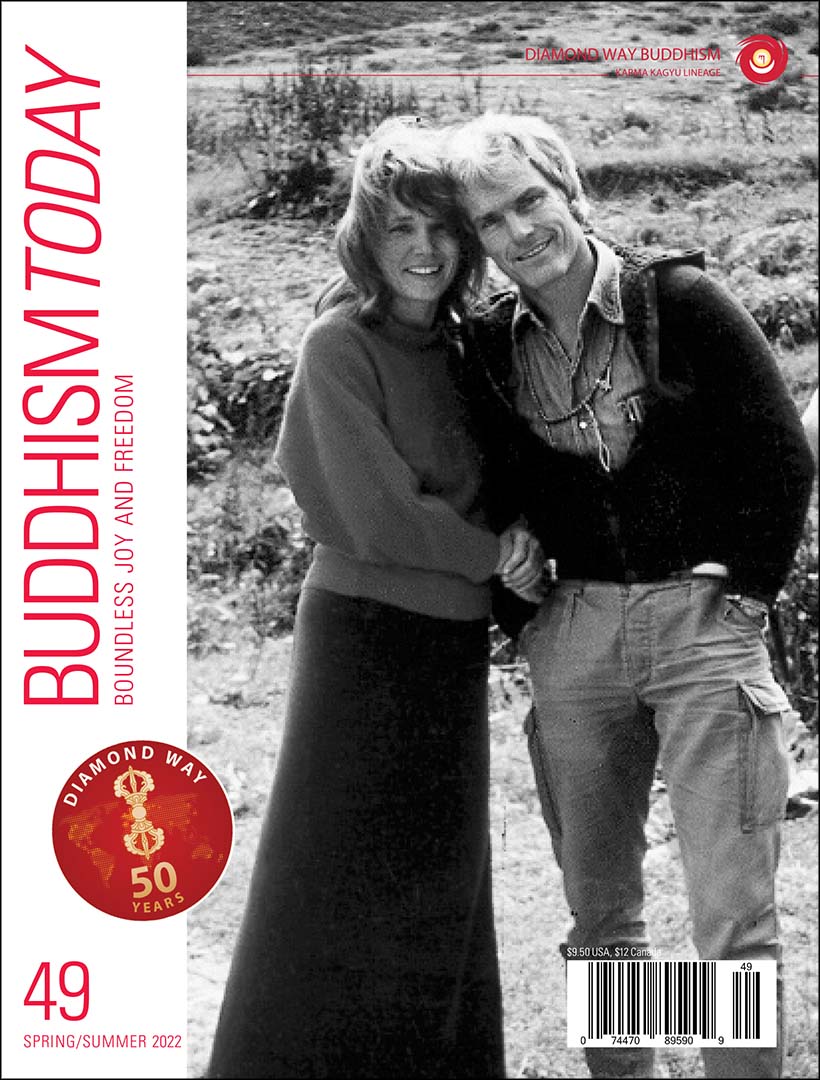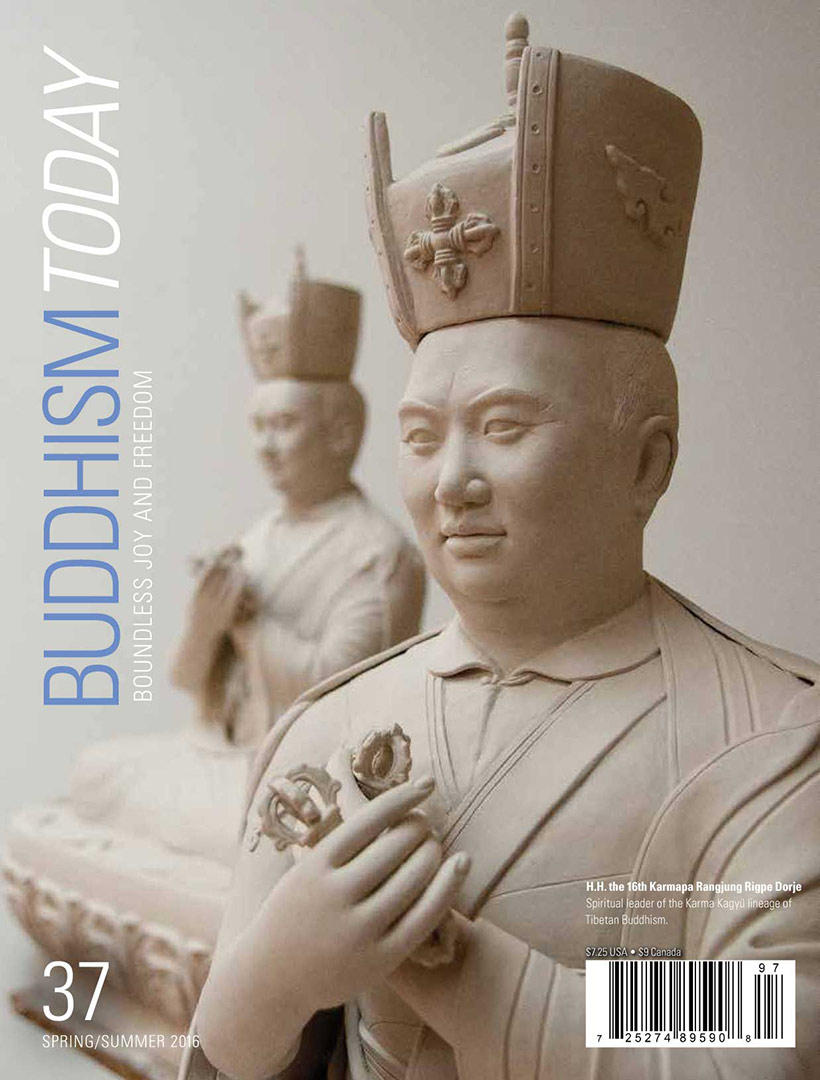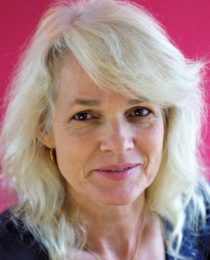Women in Buddhism
by Hannah Nydahl | Issue 37
In 1993 Lama Ole and Hannah Nydahl visited Casa Tibet in Mexico, where Hannah gave a talk on Women in Buddhism. This is an edited transcript of that talk, following by questions. It is interesting to note that during the talk Hannah mentioned that there did not seem to be much interest from women in becoming Buddhist teachers. Today, twenty-three years later, Diamond Way Buddhism has many accomplished and powerful women teachers. Hannah’s example, tireless work, deep wisdom, and gentle but unshakeable confidence have surely played a large role in this development. We are happy to share this text, one of her first public teachings in the Americas.
Hannah: Good evening everybody.
I first have to tell you what I think about Buddhism. The main teaching in Buddhism is that every single being has what we call the buddha nature, which means the potential for enlightenment. It means that our mind, the essence of our mind, is exactly the same if we are men, if we are women, if we are animals, or if we are gods. So Buddhism seen in a feminine way is something that even I don’t know. That is why I think the best thing would be for me to answer any questions that you would like to ask me.
Most of the Buddhist teachers that you have seen have probably been men. Actually, in Tibet there were both male and female lamas, but the Tibetan teachers that we see here in the West are nearly all male. We hear the question very often: why are there no women Buddhist teachers? In Buddhism there are no rules about this. It is not a religion where women are not allowed to be teachers, as you have in certain other religions. Buddhism consists of methods that allow us to realize our mind, and it is completely individual.
Whoever uses the Buddhist methods will get the results. The methods are of many different kinds. The differences in the methods are not that there are certain methods for men and others for women. The differences are related more to what kind of attitude each person has. Each person has to find the method that suits him or her. In Tibetan Buddhism we are very lucky because we have the opportunity to practice nearly all the methods that the Buddha gave.
I think that most of you who are here are Buddhists? Have you taken refuge? Maybe some of you did so some time ago, and maybe some only yesterday. If one has taken refuge it means that one wants to follow the methods the Buddha gave. This is what is important.
In Buddhism what we need to do is to integrate the methods into our lives. Buddhism is not something abstract or different from the life we live. It is a very clear decision that we want to use our lives in a meaningful way. We see that the situation in the world is full of problems and that it is difficult. We understand that all of these problems come from ourselves. We understand that the problems come from all the beings that live in this world. We then decide that we want to learn more so that we can help all beings.
The main way we can practice in our daily lives is by having a certain framework in our day. We always start in the morning by making a really strong wish that everything we do is something that will benefit others. Then we try in all our work, whatever we do, to be more awake and more aware of our minds—not just going up and down depending what happens on the outside, but trying to keep more mindfulness. Then, if we have the opportunity, we can get into a more regular practice where we sit down and do some meditation. The important thing is that we have it with us all the time.
During this course, the teachings about mind have been explained in detail. If there is something you would like to ask me because I am a woman and you think I could say something that you think you normally would not hear, then please ask me.
What is your role as a Buddhist teacher?
Hannah: When Ole and I married we went to Nepal. This was our first contact with Buddhism. We met His Holiness the 16th Karmapa and his example was so convincing that we decided to stay. Then Ole and I went through the training together. We stayed there for some years and we received a lot of teachings and we did all the basic practices.
One day when we went to Rumtek to see His Holiness Karmapa, our teacher, which we tried to do as often as we could, he suddenly told us that we should go back to Europe. This was a very big surprise to us. We had not thought of that possibility at all. Apparently it was the time when a lot of people were ready to connect with Buddhism.
Sure enough, when we came to Europe big development started. In the beginning we did everything together. Ole was the main teacher, of course, but we did it together. His Holiness Karmapa had given us different functions because at that time Buddhism was completely new in Europe and he had sent us to prepare people and to connect them with Buddhism. Then he sent some of his lamas there and I was given the function of being the translator for them.
So our background and our training is the same, but we developed into having different functions. This became a well-rounded, very positive thing for the development because we need our roots, we need the direct transmissions from our lineage, and, at the same time, it was not really possible to do it without somebody like Ole to first make the bridge. In this way, Ole is the Lama who is the teacher and I became the translator. Because the topic here is women and Buddhism, when people ask about why there are so few women teachers, I always explain that apparently there are not so many women who want to do it.
What form of Buddhist practice would you recommend for women who are very busy with their families?
Hannah: This is related to what I said a moment ago. I said that Buddhism is really something that you live. It should be completely integrated into your life. For that reason, it is not a handicap to be a woman who is occupied with a family. Of course one can practice Buddhism very well in that situation. You try to get used to having that kind of framework in your life, trying to consciously start your day by making strong wishes. This is something we might not think is important, but actually wishes are very important because the wishes give us the power to do something.
If you try to do this as a natural thing, to generally wish all beings enlightenment as the highest happiness ever, then this will give you perspective in your life. It is something that will influence everything you do because whenever you are with other people, whether it is your children, your husband, or your friends, then you know this really sincere wish will come out as something positive. Whenever you get into some kind of conflict, then it will help you not to fall into that conflict. You won’t take things so personally anymore. It will make it possible for you to give more of yourself, which will also influence the people who are with you.
One classic example in Buddhism for developing compassion is to think of one’s mother as the person to whom one should be most grateful, and to love all sentient beings as much as a mother loves her only child. The reason for using that as an example is because there is a very positive potential in it. It is something one can develop. Even if one cannot find several hours a day to sit down for meditation, one can definitely always find ten or fifteen minutes sometime during the day.
Try to have a very simple practice such as the three lights meditation or perhaps another one you like such as Chenrezig. It should be something you like. Try to do it every day, even for a very short time. You will see that, if you get into this habit, it will give a kind of inner strength. It will help you to keep your awareness, as I talked about before, like trying to be more mindful.
To train mindfulness, it is helpful to do a little bit of seated meditation practice because usually the mind is quite distracted all the time and its habit is very strong. To change that habit, all these small periods of sitting a little bit every day will definitely make you strong. Then maybe sometimes you have a little more time and then you can sit longer. Another thing that is very helpful is to say mantras. This one can do in any situation. This you can do when you are cooking, when you are working, when you are walking, or when you are talking. Use the mantras karmapa chenno or om mani peme hung or whatever you feel like.
Can you address having children in relation to Buddhist practice?
Hannah: I would say that, whenever one has a child, see it as giving the opportunity to another being, in the best case, to develop toward enlightenment. Of course, you can never force another being to practice a certain task, but you can help the conditions to come together for the being to develop in a certain way. In Buddhism a newly born being is not your being. It is a completely independent being who has its own karma. The reason that he or she is born with you is that there is some kind of connection, and this connection can be very positive, it can be negative, or it can be mixed.
This is very good to be aware of because, even when you do what you can for the child, you never know. If the child suddenly develops in a very different way than you had expected, then this understanding will help you and there will be less conflict.
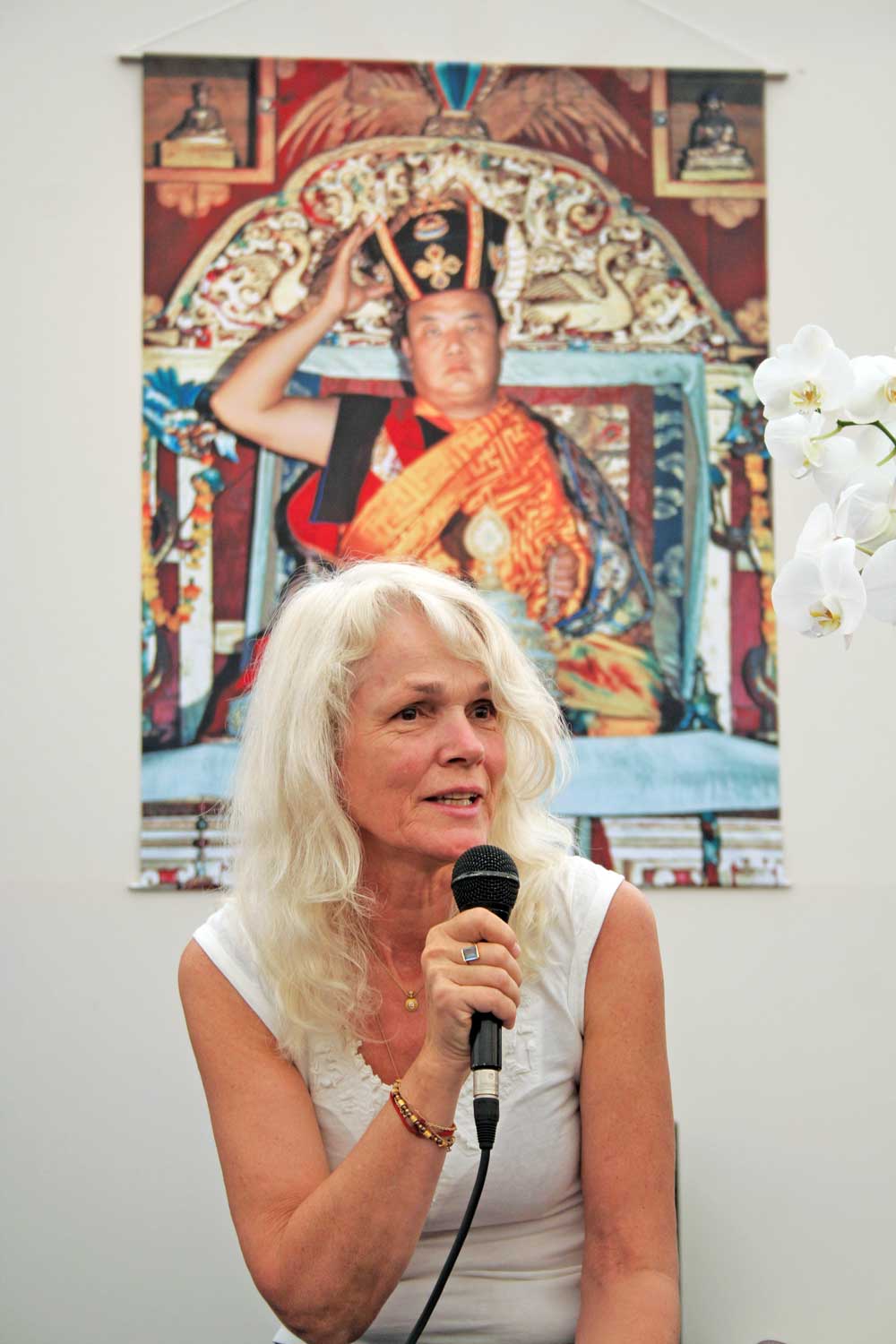 Hannah Nydahl
Hannah Nydahl
The mental strength that you get through your practice, through the good wishes, and through the training of your mind will help you in any situation and it will make you stronger. You will not feel this kind of lack of energy in the same way.
Why do you imagine that it should be an obstacle? I don’t have any children so maybe that’s easy for me to say. The reason that I don’t have children is that Ole and I had to make a choice. When we were assigned these functions that I just mentioned, then we had to choose if we wanted to have our own children or many students. That was my own fate, but
I think that if somebody has a family and has children, or wants to have children, then of course it is a responsibility. This means that one should probably only have as many children as one thinks one can help in this way. When one has them, the practice is to help the children. Then having children is not an obstacle; then it is also dharma practice. If you consider it an obstacle, then you are actually going away from dharma.
What are the differences between men and women and their respective karmas?
Hannah: It is obviously a different karma being a man or a woman, but once you decide to practice, then it does not matter anymore. The methods that we use help you to get rid of your negative karma. Whatever it is does not really matter because the root of our problem is our ignorance and all the disturbing emotions that come through our ignorance. This is what we work with. This is what we purify and transform when we practice. This is the same whether one is a man or a woman.
What are male and female buddha aspects?
Hannah: This is a little confusing because it involves the absolute and the relative. We have the different buddha aspects, the male aspect and the female aspect. They symbolize different qualities of our mind. The qualities that they symbolize are present in both male and female. It is not that the female buddhas are for women and the male ones are for men. The female buddhas symbolize the emptiness of the mind, or the wisdom, and the male buddhas symbolize the activity, the methods and the joy. The essence of our mind, which we all have, has both of these qualities; they are inseparable.
When we meditate on the different buddhas, this is a very efficient way to bring forth the qualities that are already in our mind. These are some of the most efficient methods that the Buddha gave. Everything that you see on the different buddha aspects—the different ornaments they wear, how they hold their hands, how they sit—these are all expressions of inherent qualities of our own mind. So, when we identify with them, it helps all these qualities to appear in us. Actually, you can say that the female is the wisdom and the male is like the joy. When you are able to completely identify with one, whether it is a male buddha or a female buddha, then you have realized the whole thing.
Should female practitioners choose a meditation practice based on certain attributes or based on gender?
Hannah: This is very individual. Of course, you can say that many women would naturally have an easy time identifying with Dölma because Tara is the female expression of compassion and protection, but it is not always like that. A woman can also have another yidam, as it is called. There are no fixed rules for that. It is very individual. If you have a teacher, then you can see if there is one of the buddha aspects that you naturally like very much and which feels very familiar. This is a sign that it is a good practice for you to work with this buddha aspect. If you do not have any special connection to a certain buddha aspect, then you can wait and, when you have time, do some general practices. Perhaps you can meditate a lot on Chenrezig, which helps very much to develop your compassion.
If you later want to do a more concentrated practice, then you can ask your teacher if there is any special buddha aspect that is useful for you. Usually you should just go by what you feel most familiar with. Also understand that they all are actually the same. Understand that they are all like the key to your mind. The more you can identify, the faster you can get to the experience of your mind. Here one thing is important to mention. Remember the significance of the lama. Even when you are meditating on Chenrezig or Tara, for example, each is just another form of the lama. The forms are not different from the lama. You should not see it as something different. The form is just another way for you to understand the mind.
What can we do if our spouse is not Buddhist and discourages us, or even prohibits us, from practicing?
Hannah: This comes up everywhere, not only in Mexico. I would say that being a good example is the best solution. Of course, whenever both partners have the same interest in Buddhism, this is ideal. When this is not the case and one is not a Buddhist, whether it is the man or the woman, then you have to just try to be a good Buddhist. You should not try to convince the other person that he or she should also follow the path. Try the best you can to learn and practice and, if your husband or wife then starts asking you questions or wants to know more, you can tell them more and explain something. Of course, if your husband doesn’t want you to practice this is difficult. You will have to train your patience. Try to avoid arguments about it. It is not really something that one can argue about.
What about practicing discreetly if one’s partner or family does not approve of Buddhism?
Hannah: You can be a Buddhist without everybody knowing it just by looking at you, so such situations will not prevent you from doing your practice. Of course, it is nice if you can have something in common. It is nice if Buddhism is not something you have to fight about, but for your own development it does not have to be this way. Remember that to respect the other person is important. If he or she has another view, then you have to respect that.
How does one choose a spiritual path in life? Is it a good idea to select a spiritual path when one is facing a moment of difficulty or a life crisis?
Hannah: The first question about how to find your way or your path is individual. Some already have a strong connection with a certain path, so when they connect with it then there is absolutely no doubt in them that this is their way. In this case, one has probably done the practices before. If one does not have that kind of experience, then you have to look around a little bit and see where you feel you can connect. For that, you also have to clarify for yourself what you actually want—whether you only want something for yourself, or if you want to go further and also want to learn something for others.
The different spiritual paths or religions emphasize different things. If you have been looking and, until now, you haven’t really connected individually with anything, particularly if you are looking especially hard when you have problems, this is quite normal. Try to see and to think more about the fact that you are not the only one having problems; remember that everybody has problems. Turn it more into that, try to make it bigger, to get it more into perspective. Then look for something that will help not only you, but everybody.
How did you choose to become Buddhist?
Hannah: In my case, there must have been some connection before. Since childhood, I have always had many questions. You know I come from Denmark, which is actually a very irreligious place. It is Christian, but Danish Protestantism is not very convincing. I had many questions about things, about the world and what we are all doing here, and I never found any answers. The answers I got I did not find satisfactory. I must admit I never believed in a creator god. I could not understand this. The first time I read something about Buddhism was a text by a teacher named Gampopa, which explained from the very beginning, very relative teachings like daily teachings, up to the highest in Diamond Way teachings, absolute teachings. Then it was just like all my questions were answered and it was the happiest time in my life.
Who do you believe created you?
Hannah: Who created me? I created myself. The things you do, you say, and you think all leave impressions in your mind. I believe that we have lived many, many times and that all these impressions will take a form. This is what I am, what you are, what everybody is, according to the impressions that are in your mind.
How does mind begin and end? Does mind have a beginning or an end?
Hannah: The mind, the absolute mind, the true mind, the pure mind is without beginning and end. In Buddhism then, when you realize this pure mind, it means you are a buddha. When you have not realized your mind, it means you are an ordinary being. That is the only difference between ordinary beings and buddhas. So the whole Buddhist path is really to use methods that help you take away whatever prevents you from seeing your mind.
I work in a hospital with troubled patients who are going through adolescence. So, I have trouble visualizing dakinis or bodhisattvas as youthful. What should I do?
Hannah: The thing is, it depends on how strong the mental habits are. You have very strong mental habits so it is difficult for you to transform them, but it does not matter. What is important is that, when we do the practice, we try to follow whatever practice we are doing. We do it as well as we can. We understand that it is a method and try not to think that it has to be like this or like that. When it is easy and you manage it, you get happy. When you don’t manage, then you may think you are not doing it right. What we try to learn is to train our minds to be natural and to not be attached to whatever happens in the mind. So when you do not succeed, don’t think, “Well now I can’t do it and it is not good.” Just try to keep neutral in your mind and do it again and again.
How can I guide my son to develop concentration and consciousness?
Hannah: The example is the most important. If you are able to show these positive things, then your child will naturally want to imitate those qualities. The child will naturally want to listen when you say something. If you say one thing but do something else, the result may not be so good. At the same time, don’t expect it to always work. The child might have some different karma. The child may have some tendencies that are not so easy. Try to give the child enough confidence that he will come to you when he has problems later in life.
Which meditation practices do you recommend for children?
Hannah: Mantras, if they like. Many dharma friends who have children find that the children often naturally like to come and join and just sit. They are not taught how to meditate, but they just like it. You cannot do very much. You can just be good to them and try to guide them in life and hope that they find their way. Teach them the basic qualities in life. These belong to many world religions—values like compassion, patience, and generosity all are positive. You can always try to inspire and develop them.
What is the role of women practitioners in European countries?
Hannah: This is different from country to country, but generally there are many women practitioners in the West. In Europe, for instance, in many centers the main people who are running the centers are women. Then again you have places where you have many men. Norway is quite interesting, in that the center in Norway is nearly all men. In Russia, it is very equal. I think it has a little bit to do with the cultural background.
Does practicing a meditation in which one identifies with a buddha aspect end up increasing pride and increasing the ego because one seems to be identifying oneself with a powerful buddhist deity?
Hannah: A buddha aspect does not have an ego. When you identify with the aspect, it is a very skillful way for you to get rid of your ego. This is extremely important to understand. This is the whole point. The more you can identify with this perfect form, which is actually your true nature, the less ego you will have. A buddha is not angry, a buddha is not jealous, a buddha is not proud. So the more you can identify with these pure forms, the less you will have of these disturbing emotions. You are using the word pride, but it is not the same as normal pride. It means more like identification. By identifying with this form, which is an outer form, it actually becomes no different from you. It is the way to realize your own pure form, which is without all these disturbing feelings. Then there is no ego.
Lama Ole: I just want to add that there are two kinds of pride. There is inclusive pride and exclusive pride. The exclusive pride says, “Oh, I am better than you.” This of course only brings negativity. The inclusive pride says, “Aren’t we all wonderful.” This gives a lot of good energy for the work. Also, everybody is in the mandala, everybody is a buddha at the same time. It just lifts your level of experience to a point where negativity is meaningless.
Do the practices work for beginners who are starting to practice and still experience pride and ego?
Hannah: Of course. The methods are designed to ensure progress. Every one of our practices is a complete thing. One starts by taking refuge. Next, one develops bodhicitta, which means one does not simply want to just have a good time for oneself. You think, “I want to do this practice to be able to help other beings.” When one finishes the practice, you dedicate whatever positive impressions you have accumulated to all other beings. It means that even if during the meditation something was not okay, it does not matter. Everything goes in the right direction. You are safe because of this framework. We all make mistakes. That’s why we do the practice. You just have to do your best all the time. You can be sure that, if you use the methods, they do bring the results. The result is that the ego diminishes and you become more loving toward others and you can do more for others.
Can you address marriage in Buddhism?
Hannah: Marriage is very individual and has a lot to do with the culture in which you are living. The Buddhist view is to not harm anybody. So it depends on the relationship you have. Generally the relationship between men and women is the point where you can experience both the strongest happiness and the strongest suffering on the worldly level. So it is a very vulnerable thing. It depends on what kind of relationship you have, whether you are hurting somebody or not. That is the Buddhist view.
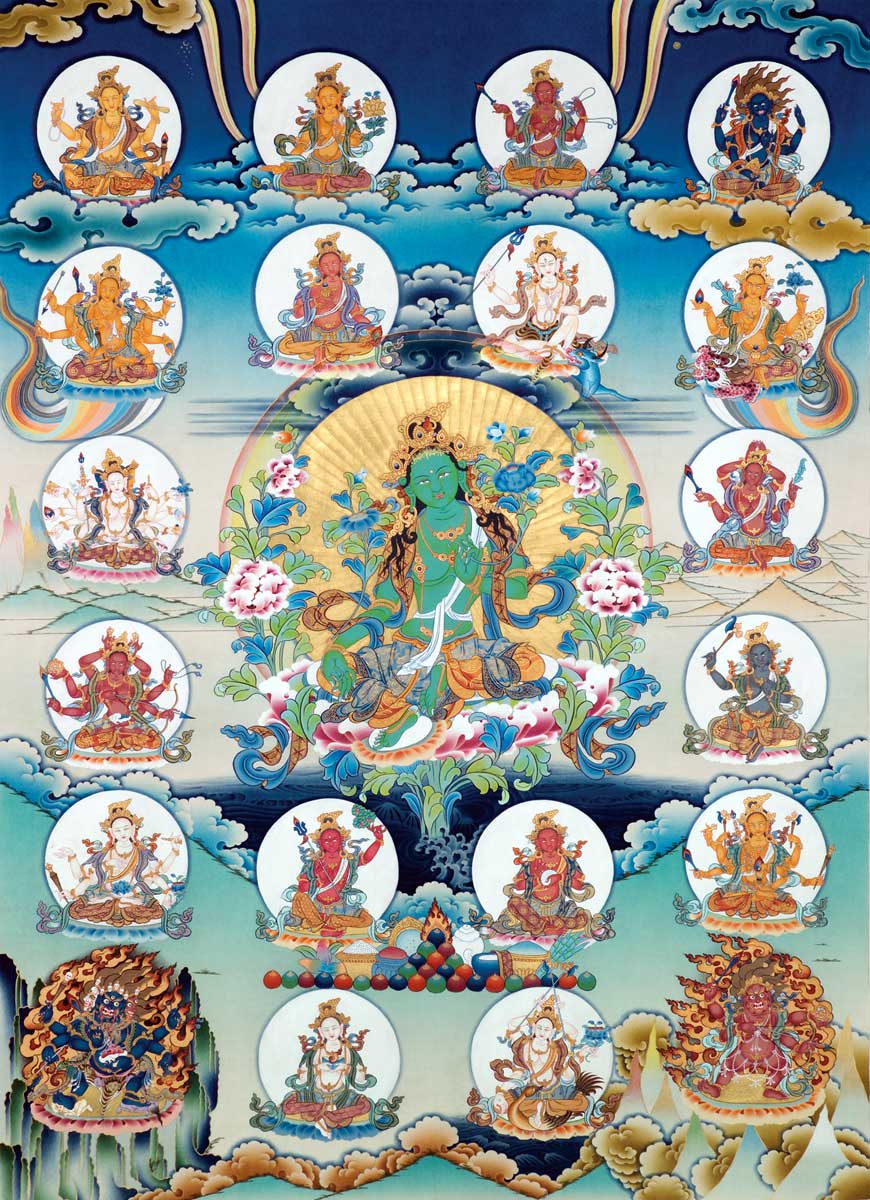 Taras
Taras
What is the practice of twenty-one Taras?
Hannah: I think that is a whole teaching in itself. It is very particular because Tara is the female aspect of compassion and is a very quick activity, protecting beings against all kinds of fear and danger. The twenty-one aspects of Tara have to do with protecting against different kinds of fear. It can be the danger of the elements, it can be danger of war, danger of robbery, sickness, and all kinds of things. They each have a special mantra, but the Green Tara in the center includes all of them. The root mantra of Tara can be used for all of them.
What do you think about abortion in extreme conditions, like when a woman is raped or assaulted or is not really able to take care of the child?
Hannah: Buddhism explains how things are. It explains about cause and effect. Then it is up to each being to conclude from that. Concerning abortion, there is a life and abortion is killing a being. You can’t really say anything else. It is difficult, for example, if somebody is about to die or wants to die or is sure to die later. We may wonder whether it is okay to help that person to die more quickly or not. This is the same kind of question. As hard as it might sound, you cannot actually help somebody by killing them.
Even if this person-—this being-—is suffering, still you cannot stop that suffering by killing them. The cause of the suffering will still be there. The existence goes on and it will just come in another form. You can try to help to relieve pain. For example, if it is a young girl who got pregnant by rape, you can help
to see that the child is adopted, perhaps by a family that cannot have children.
There are many ways you can try to help which do not involve killing. You cannot stop the cause of this person being in that state by killing the person. Another birth will follow in the same state.
Were women of equal status to men in Tibet?
Hannah: In Asia, usually the women were not equal. Compared to other countries, the position of the woman in Tibet was actually quite extraordinary. There was always the possibility for women to break out of the social system, if they had the qualities and wanted to. There were many great yoginis in Tibet and they were pretty well respected. If they were in a family, the women were responsible for the children.
Many of your questions cannot be answered by a yes or no. Buddhism is not a culture. It is a practice that can be done in many different cultures. In Tibet it was very common in the families that, when the parents were around forty or so and their children had grown up, they would go into a retreat. Often they would alternate. The mother would do a retreat for some time and the father would watch the house, and then the father would do a retreat. If they were lay people they would often do more practice later in their life. Then the children would help to support them.
